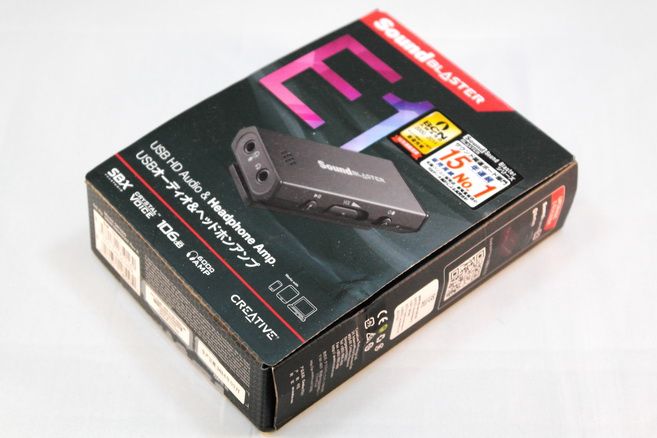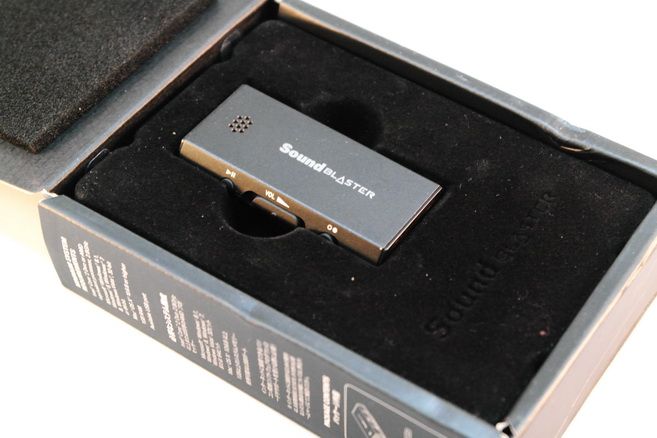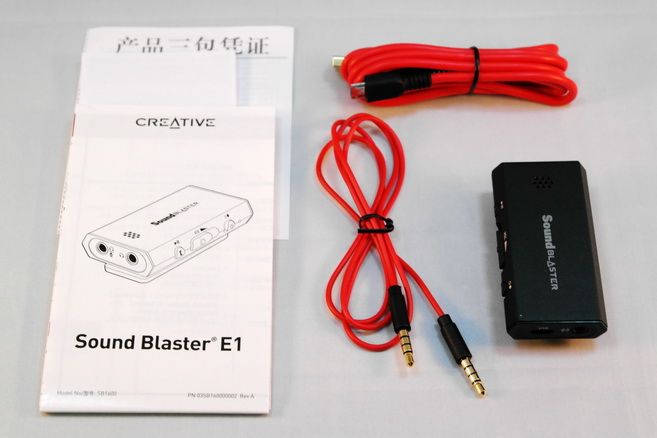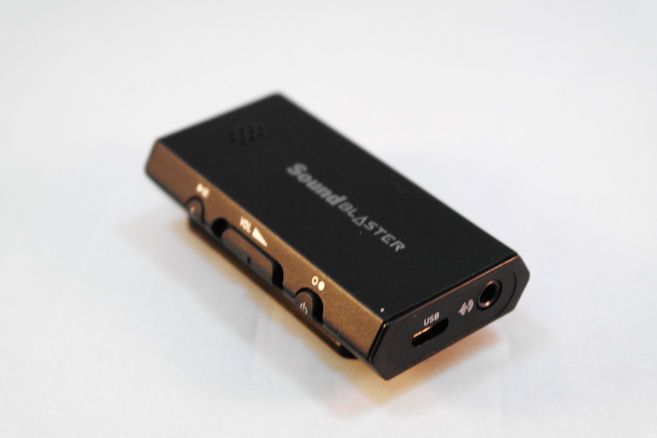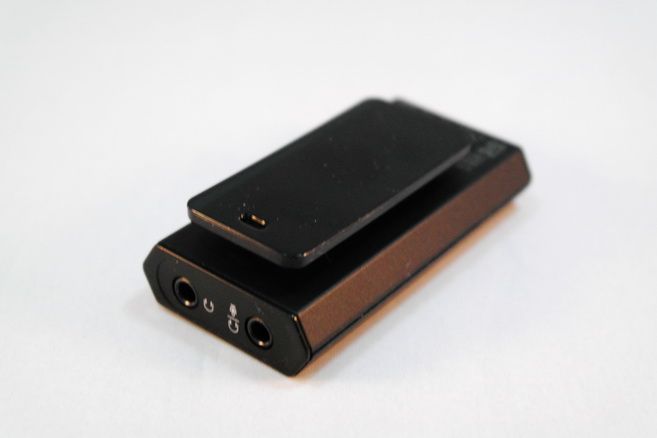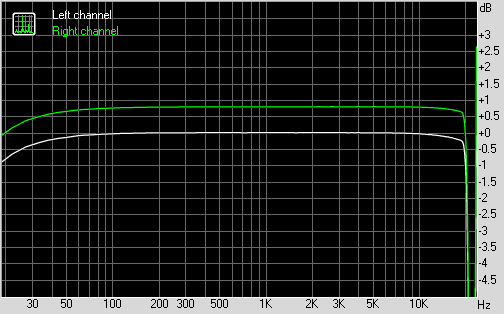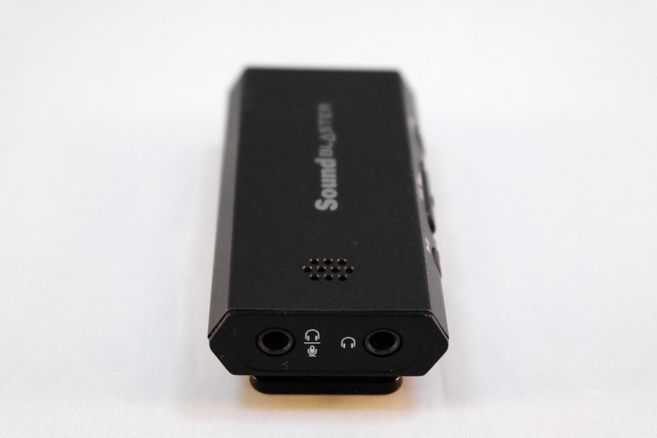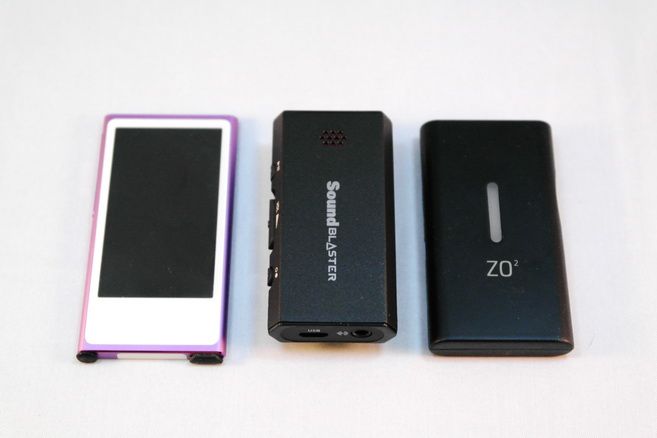Creative's Sound Blaster E1
If you want to cover your bases with a do-all headphone accessory, the E1 is a good start. Affordable, well featured, inexpensive, the E1 is Creative's entry-level portable DSP, DAC, and amp all-in-one. Forgive the "classic" analogy, but this piece of equipment is very much like a Swiss Army knife... Each tool may not be the very best for every task, but it's small enough to always have around and very handy in many areas.

The E1 is built compact and thoughtfully, just like a Swiss Army Knife (SAK). Like a SAK's plastic side scales, the E1 is small and made of plastic. It has thoughtful design details that are obvious like a clip to attach to belts and clothes, and less obvious details like how the sides are angled and the clip is "just so" wide so that you can set the E1 down on a desk at a 45° angle so the mic points up at you (more on the Microphone later). The analogue input is TRRS, so on Android you can answer phone calls or pause music, and on iOS (or when plugged into a computer via USB) you can use all the buttons on the E1 to skip tracks and fast forward as well as everything you can do on Android. For volume control, they went with an analogue slider; At really low volumes this introduces some channel imbalances (different volume in each ear), but on the plus side it works with an analogue connection to Android and you can visually see what the volume is set at. The volume slider is also plastic so it's not the most precise thing to adjust, but it works.
The E1 is also festooned with multiple Audio tools and features. Just like people debate that you don't really need scissors (two blades) on a knife tool, sometimes it's just handy to have two headphone outputs (each with their own independent OpAmp buffer, so plugging in two headphones doesn't result in less volume than one headphone). The headphone outputs also have very low output impedance, which means multi-driver in-ear monitor (IEM) headphones won't suffer from bass bloat or rough transitions at the crossover point between drivers. The second headphone jack can also act as a mic input if you have a computer headset with two plugs, but not a TRRS passthrough if your headphone has a mic built-in. There's a mic built-in to the body of the E1, and I can confirm that it works with a Playstation 4's controller input/output if you don't have another mic solution. I've gotta say, the 3.5mm jacks on this device were really tight, I had to really push extra hard to "click" any cable into any of the ports. The DAC connects to your computer via USB (bypassing your motherboard audio). The E1's PC software suite includes the excellent SBX processing suite for tweaking audio and mic settings, including virtual surround processing for regular stereo headphones. To top off all those features, the amp is rated for about 22 hours of operation between charges.


Opinion on the design and features so far... With just one little little utility-belt contraption, the mobile audio-hero has all the parts needed for a full gaming-audio system. If you need portable audio often, the Creative E1 will set a higher baseline for audio quality than what you get built-in to a cheap laptop, very similar to the FiiO – brand E7 DAC/Amp combo that came out years ago (except Creative's products come with Virtual Surround, a key benefit to gamers and movie buffs). With such a buffet, it's hard to expect more, but I think it would've been awesome if the dual-headphone jacks had been configured to also make balanced-output possible like the Pono music player... crazy talk to the target market looking to buy an approximately $50 device. Crazy because a balanced headphone, conversion, or cable would be expensive, so why even write about it? 3 reasons: 1.) the power output of the E1 seems optimal for easy to drive headphones like IEMs, 2.) multi-driver IEMs recently became much more prevalent and the E1's output impedance seems optimal for those, and if you can easily make your IEM balanced then 3.) balanced amplification output ought to significantly improve the E1's sound quality, specifically soundstage and detail presentation.
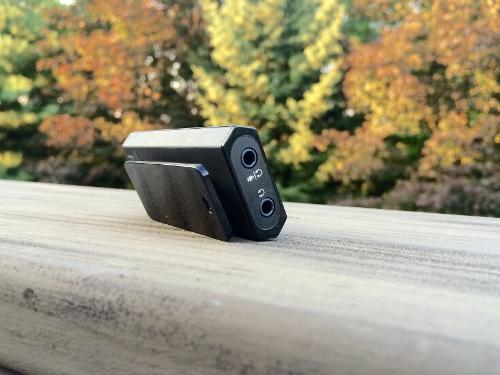
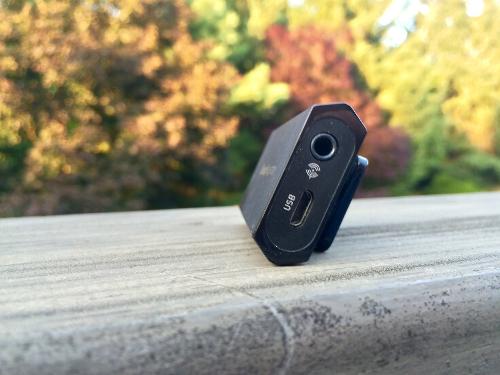
Sound quality of the E1 is solidly entry-level, appropriate for it's price point. The frequency response is slightly warm, intimate, and has a smooth treble. Probably a great match with Counter-Strike: Global Offensive and music with sharp treble, or to balance out a light and bright headphone like the Audio Technica AD700, the E1 does a great job keeping audio from being fatiguing, but on the flipside the sound has less "air" and sense of soundstage depth. Interference from being close to a phone is also very low. This is on par with what I heard from the FiiO E5 amp and comparably priced and spec'd FiiO E7, but the Creative adds to this the advantage of SBX surround processing while PC gaming over USB... but the elephant in the room is that Creative's E1 doesn't add anything to the sound quality over plugging my headphones straight into my iPhone 5S. The iPhone and E1 sound very close in quality (and could get deafening loud) with my V-Moda M-100, Koss KSC75, and Audeo PFE-022 IEMs, but my mid-impedance and low-sensitivity AKG K612 require more current than the E1 has to offer and sound weak in the bass regions. For perspective, my iPhone 5S would be a $550-$650 device today versus the $50 E1 and comparable amps, and the iPhone beats the sound quality coming from my PC that cost about as much as the phone and my family member's cheaper Android devices have weaker amps. Those would benefit more from the E1; for example, my $120 motherboard makes a little noise through headphones when I move my mouse and has a "veil" in front of the music that the E1 cleans away.
So, in total, what does the E1 offer, and who is it for? The E1 may not be a purpose built cheese knife or screwdriver, but it will save the day at a nice budget price. It has a very nice small physical enclosure with lots of features, it is well-suited for your average headphone and especially IEMs, and can "fix" bad audio from laptops, desktop motherboards, and cheap smartdevices, while also offering the bonus of headphone surround. If you have a flagship smartphone or nice DAP, all you should expect to gain is a mic, dual outputs, remote controls, and you can turn down the volume on your source and save battery life in that.
If you want to cover your bases with a do-all headphone accessory, the E1 is a good start. Affordable, well featured, inexpensive, the E1 is Creative's entry-level portable DSP, DAC, and amp all-in-one. Forgive the "classic" analogy, but this piece of equipment is very much like a Swiss Army knife... Each tool may not be the very best for every task, but it's small enough to always have around and very handy in many areas.

The E1 is built compact and thoughtfully, just like a Swiss Army Knife (SAK). Like a SAK's plastic side scales, the E1 is small and made of plastic. It has thoughtful design details that are obvious like a clip to attach to belts and clothes, and less obvious details like how the sides are angled and the clip is "just so" wide so that you can set the E1 down on a desk at a 45° angle so the mic points up at you (more on the Microphone later). The analogue input is TRRS, so on Android you can answer phone calls or pause music, and on iOS (or when plugged into a computer via USB) you can use all the buttons on the E1 to skip tracks and fast forward as well as everything you can do on Android. For volume control, they went with an analogue slider; At really low volumes this introduces some channel imbalances (different volume in each ear), but on the plus side it works with an analogue connection to Android and you can visually see what the volume is set at. The volume slider is also plastic so it's not the most precise thing to adjust, but it works.
The E1 is also festooned with multiple Audio tools and features. Just like people debate that you don't really need scissors (two blades) on a knife tool, sometimes it's just handy to have two headphone outputs (each with their own independent OpAmp buffer, so plugging in two headphones doesn't result in less volume than one headphone). The headphone outputs also have very low output impedance, which means multi-driver in-ear monitor (IEM) headphones won't suffer from bass bloat or rough transitions at the crossover point between drivers. The second headphone jack can also act as a mic input if you have a computer headset with two plugs, but not a TRRS passthrough if your headphone has a mic built-in. There's a mic built-in to the body of the E1, and I can confirm that it works with a Playstation 4's controller input/output if you don't have another mic solution. I've gotta say, the 3.5mm jacks on this device were really tight, I had to really push extra hard to "click" any cable into any of the ports. The DAC connects to your computer via USB (bypassing your motherboard audio). The E1's PC software suite includes the excellent SBX processing suite for tweaking audio and mic settings, including virtual surround processing for regular stereo headphones. To top off all those features, the amp is rated for about 22 hours of operation between charges.


Opinion on the design and features so far... With just one little little utility-belt contraption, the mobile audio-hero has all the parts needed for a full gaming-audio system. If you need portable audio often, the Creative E1 will set a higher baseline for audio quality than what you get built-in to a cheap laptop, very similar to the FiiO – brand E7 DAC/Amp combo that came out years ago (except Creative's products come with Virtual Surround, a key benefit to gamers and movie buffs). With such a buffet, it's hard to expect more, but I think it would've been awesome if the dual-headphone jacks had been configured to also make balanced-output possible like the Pono music player... crazy talk to the target market looking to buy an approximately $50 device. Crazy because a balanced headphone, conversion, or cable would be expensive, so why even write about it? 3 reasons: 1.) the power output of the E1 seems optimal for easy to drive headphones like IEMs, 2.) multi-driver IEMs recently became much more prevalent and the E1's output impedance seems optimal for those, and if you can easily make your IEM balanced then 3.) balanced amplification output ought to significantly improve the E1's sound quality, specifically soundstage and detail presentation.


Sound quality of the E1 is solidly entry-level, appropriate for it's price point. The frequency response is slightly warm, intimate, and has a smooth treble. Probably a great match with Counter-Strike: Global Offensive and music with sharp treble, or to balance out a light and bright headphone like the Audio Technica AD700, the E1 does a great job keeping audio from being fatiguing, but on the flipside the sound has less "air" and sense of soundstage depth. Interference from being close to a phone is also very low. This is on par with what I heard from the FiiO E5 amp and comparably priced and spec'd FiiO E7, but the Creative adds to this the advantage of SBX surround processing while PC gaming over USB... but the elephant in the room is that Creative's E1 doesn't add anything to the sound quality over plugging my headphones straight into my iPhone 5S. The iPhone and E1 sound very close in quality (and could get deafening loud) with my V-Moda M-100, Koss KSC75, and Audeo PFE-022 IEMs, but my mid-impedance and low-sensitivity AKG K612 require more current than the E1 has to offer and sound weak in the bass regions. For perspective, my iPhone 5S would be a $550-$650 device today versus the $50 E1 and comparable amps, and the iPhone beats the sound quality coming from my PC that cost about as much as the phone and my family member's cheaper Android devices have weaker amps. Those would benefit more from the E1; for example, my $120 motherboard makes a little noise through headphones when I move my mouse and has a "veil" in front of the music that the E1 cleans away.
So, in total, what does the E1 offer, and who is it for? The E1 may not be a purpose built cheese knife or screwdriver, but it will save the day at a nice budget price. It has a very nice small physical enclosure with lots of features, it is well-suited for your average headphone and especially IEMs, and can "fix" bad audio from laptops, desktop motherboards, and cheap smartdevices, while also offering the bonus of headphone surround. If you have a flagship smartphone or nice DAP, all you should expect to gain is a mic, dual outputs, remote controls, and you can turn down the volume on your source and save battery life in that.
